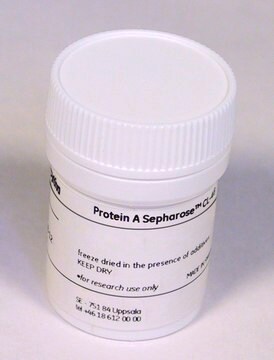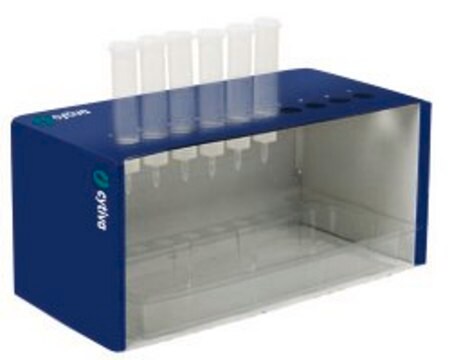GE17-0618-01
Protéine G-Sépharose™ 4 Fast Flow (à débit élevé)
Cytiva 17-0618-01, pack of 5 mL
Synonyme(s) :
Résine à haut débit, résine de purification d'anticorps, résine de purification d'IgG
About This Item
Produits recommandés
ligand
recombinant protein G lacking albumin-binding region
Conditionnement
pack of 5 mL
Fabricant/nom de marque
Cytiva 17-0618-01
Conditions de stockage
(20% Ehtanol)
Matrice
4% cross-linked agarose
Diamètre moyen
90 μm (d50v)
cleaning in place
2-10
working range
3-9
Adéquation
suitable for bioprocess medium
Température de stockage
2-8°C
Catégories apparentées
Description générale
La protéine G recombinante de ce produit est immobilisée à la Sepharose™ 4 Fast Flow par la méthode du bromure de cyanogène (CNBr). La protéine G présente des spécificités de liaison complémentaires à celles des supports de protéine A et se lie à la région Fc des IgG de différentes espèces de mammifères. La protéine G-Sepharose 4™ Fast Flow peut être utilisée pour isoler et purifier les classes, sous-classes et fragments d'immunoglobulines présents dans n'importe quel liquide biologique ou milieu de culture cellulaire.
En tant que membre de la gamme de milieux BioProcess, la protéine G-Sepharose 4™ Fast Flow répond aux besoins du secteur industriel en assurant un approvisionnement fiable et une assistance technique et réglementaire complète.
Caractéristiques et avantages
- Présente des spécificités de liaison complémentaires à celles des supports de protéine A.
- Permet de lier un vaste éventail d′IgG de diverses espèces et sous-classes.
- Plusieurs points d′attache pour minimiser la perte de ligand.
- Utilisée dans diverses applications de recherche.
Stockage et stabilité
Remarque sur l'analyse
Informations légales
Produit(s) apparenté(s)
Mention d'avertissement
Warning
Mentions de danger
Conseils de prudence
Code de la classe de stockage
3 - Flammable liquids
Certificats d'analyse (COA)
Recherchez un Certificats d'analyse (COA) en saisissant le numéro de lot du produit. Les numéros de lot figurent sur l'étiquette du produit après les mots "Lot" ou "Batch".
Déjà en possession de ce produit ?
Retrouvez la documentation relative aux produits que vous avez récemment achetés dans la Bibliothèque de documents.
Les clients ont également consulté
Articles
This page shows a comparison of the relative binding strengths of protein G and protein A to different immunoglobulins.
Purify monoclonal or polyclonal IgG from serum, cell culture supernatant or ascitic fluid using the HiTrap Protein G HP from Cytiva, an affinity-exclusion chromatography product containing Sepharose-immobilized Protein G.
This page describes immunoprecipitation (immunoaffinity or pull-down techniques).
This page describes efficient column packing and preparation for affinity chromatography of antibodies.
Protocoles
This page provides information about different pull-down assays for the further isolation of multiprotein complexes to identify their components with products from Cytiva.
This page shows how to separate IgG antibodies by affinity chromatography using Protein G Sepharose 4 Fast Flow from Cytiva.
This page shows how to separate IgG antibodies by affinity chromatography using Protein G Sepharose 4 Fast Flow from Cytiva.
Contenu apparenté
Tests, réactifs et protocoles permettant d'étudier les interactions protéines/protéines in vitro par différentes méthodes : pull-down ou GST pull-down, purification par affinité en tandem (TAP pour "Tandem Affinity Purification") et co-immunoprécipitation.
Pull-down assays, reagents, and protocols for investigating in vitro protein-protein interactions using affinity or GST pull-down, tandem affinity purification (TAP), and co-immunoprecipitation methods.
Notre équipe de scientifiques dispose d'une expérience dans tous les secteurs de la recherche, notamment en sciences de la vie, science des matériaux, synthèse chimique, chromatographie, analyse et dans de nombreux autres domaines..
Contacter notre Service technique









